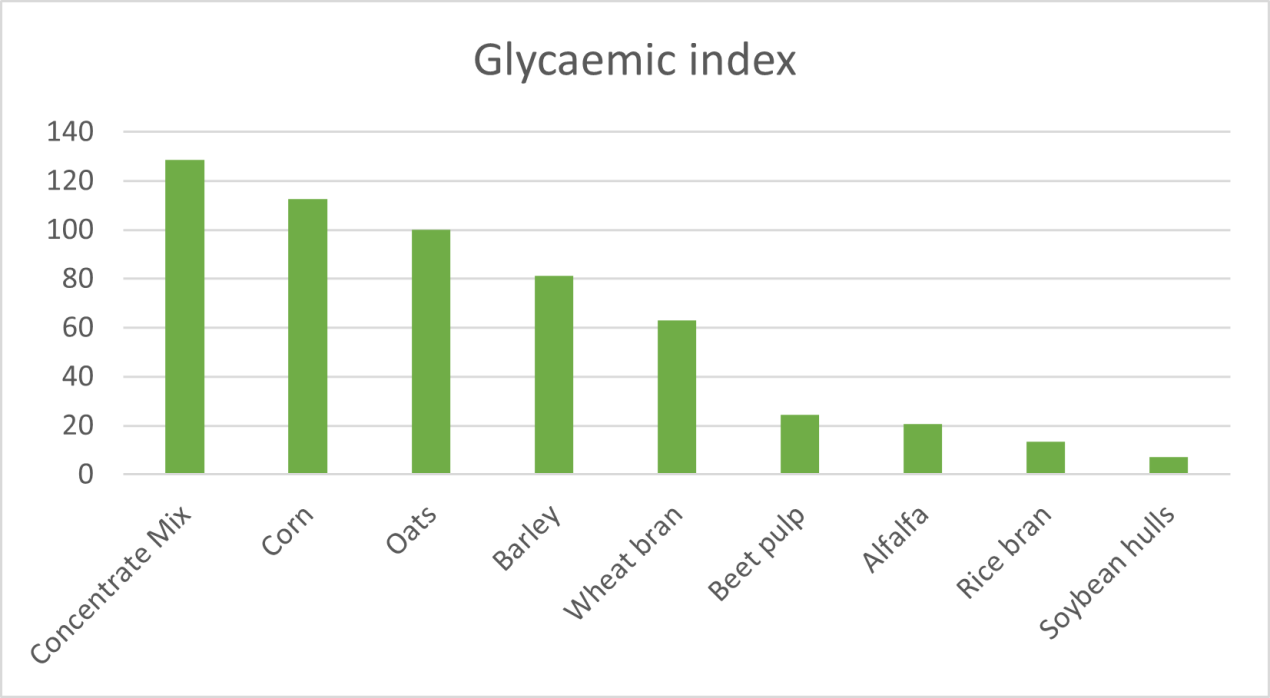Glycaemic Index In Horse Feeds
What is a glycaemic index?
The glycaemic index of a food is a ranking system for foods containing carbohydrates. The ranking system rates each food based on how it affects blood glucose levels.
The Importance of the GI of ffeds:
When creating a ration for horses with specific dietary needs such as a metabolic condition looking at the GI of the feed would be beneficial. Starch and sugars break down quickly during digestion, whereas fibre and oil sources break down more slowly, releasing glucose gradually into the bloodstream. A lower glyceamic index indicates a slower digestion of sugars and starches, creating a lower insulin demand. (Kentucky Equine Research, 2017). Horses in a high level of work who are performing more explosive type activities may benefit from a feed with a higher GI to enable them to have the energy to perform these tasks.
What feeds have a lower GI?
Cereal grains are naturally higher in starch, and so have a glycaemic index of 100, whereas fibres such as unmolassed beet pulp have a glyceamic index of 34. Feeds with a higher glycaemic index rapidly increase blood glucose, whereas diets that consist of fibre sources did not affect the blood concentrations in the same way (Brøkner, 2016).

Low GI feeds and metabolic conditions:
Equine Metabolic Syndrome (EMS) refers to the body’s reduced response to insulin. Insulin is responsible for controlling glucose levels in the blood, ensuring that glucose is circulated around the body to support many of its vital functions. Horses and ponies diagnosed with EMS are less sensitive to insulin, meaning that blood glucose concentrations take longer to come back to normal following a meal. These horses or ponies are likely to be overweight, find it more difficult to lose weight, and will develop ‘fat pads,’ most iconically in the crest of the neck. As the horse gets older, the risk of metabolic conditions such as Equine Metabolic Syndrome (EMS) and Cushings Disease (PPID) increases. Veteran horses and ponies are less able to maintain a normal blood concentration of both glucose and insulin, which can increase the risk of insulin resistance and consequently laminitis in some individuals. For horses or ponies diagnosed with a metabolic condition we would look for a feed with a lower GI to help maintain more consistent blood glucose levels, helping to reduce blood glucose spikes.
Low GI feeds and youngstock:
Recent and ongoing research suggests a relationship between the glycaemic nature of feed and the incidence of skeletal disorders, such as osteochondritis dissecans (OCD) in young horses. It appears that the normal bone formation processes in young horses are being disrupted by the elevated blood insulin (hyperinsulinemia) concentrations following the consumption of a diet rich in starch and sugars. In foals, hyperinsulinemia may affect chondrocyte maturation, leading to altered matrix metabolism and faulty mineralisation of bone. OCD lesions occur on the articular cartilage, which is the cartilage at the end of the bones that protects the joints. The skeleton starts as cartilage, so if there is a problem in the maturation of that cartilage, it can set the stage for lesions to develop. Not all young horses are affected, but some are more sensitive to high levels of glucose and insulin than others, and research suggests that it would be prudent to feed foals concentrate feeds that produce a low-glycaemic response.
Feed Advice Form
Complete our online form to receive a detailed nutritional plan for your horse or pony from one of our registered nutritionists.
Quick Feed Finder
Use our quick and easy feed finder as a guide to select the right feed for your horse or pony.












